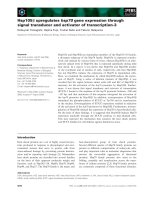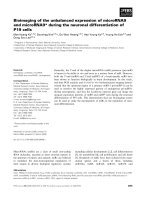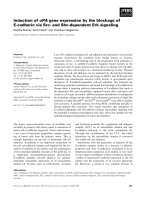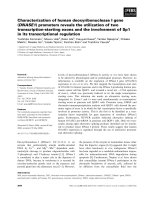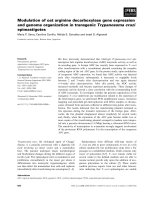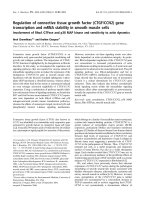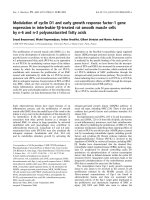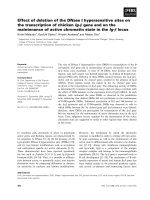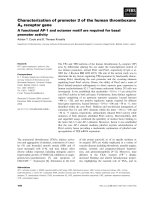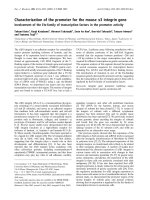Báo cáo khoa học: Ablation of Sax2 gene expression prevents diet-induced obesity docx
Bạn đang xem bản rút gọn của tài liệu. Xem và tải ngay bản đầy đủ của tài liệu tại đây (883.87 KB, 12 trang )
Ablation of Sax2 gene expression prevents diet-induced
obesity
Ruth Simon
1,2
, Stefan Britsch
2
* and Andrew Bergemann
1
*
1 Department of Pathology, Mount Sinai School of Medicine, New York, NY, USA
2 Institute for Molecular and Cellular Anatomy, University of Ulm, Germany
Introduction
Obesity is increasingly becoming a major health hazard
throughout all industrialized societies. Easy access to
high caloric food and a sedentary life style are the
main causes for the increase in obesity and related
health risks, including diabetes mellitus and cardiovas-
cular diseases. Great efforts are being made to under-
stand the regulation of energy homeostasis and to find
ways of reducing the obesity epidemic and related
health risks. The regulation of energy homeostasis
occurs by a complex circuitry in the brain, particularly
in the hypothalamus and brainstem. These brain
circuitries integrate and coordinate several types of sig-
nals from the periphery, as well as from other parts of
the brain, including neurotransmitters, hormones and
nutrients, and translate them into feeding behavior,
thereby controlling energy uptake and expenditure.
Peripheral signals, including adiposity signals arising
from adipose tissue and the pancreas, as well as signals
from the gastrointestinal tract, interact with specific
neurons of the hypothalamus and the brainstem,
Keywords
brainstem; diet-induced obesity; energy
homeostasis; food uptake; neural circuitry
Correspondence
R. Simon, Institute for Molecular and
Cellular Anatomy, University of Ulm, Albert-
Einstein-Allee 11, D-89081 Ulm, Germany
Fax: +49 731 500 23102
Tel: +49 731 500 23225
E-mail:
*These authors contributed equally to this
work
(Received 19 July 2010, revised 5
November 2010, accepted 11 November
2010)
doi:10.1111/j.1742-4658.2010.07960.x
Regulation of energy homeostasis is mainly mediated by factors in the
hypothalamus and the brainstem. Understanding these regulatory mecha-
nisms is of great clinical relevance in the treatment of obesity and related
diseases. The homeobox gene Sax2 is expressed predominantly in the
brainstem, in the vicinity of serotonergic neurons, and in the ventral neural
tube starting during early development. Previously, we have shown that the
loss of function of the Sax2 gene in mouse causes growth retardation start-
ing at birth and a high rate of postnatal lethality, as well as a dramatic
metabolic phenotype. To further define the role of Sax2 in energy homeo-
stasis, age-matched adult wild-type, Sax2 heterozygous and null mutant
animals were exposed to a high-fat diet. Although food uptake among the
different groups was comparable, Sax2 null mutants fed a high-fat diet
exhibited a significantly lower weight gain compared to control animals.
Unlike their counterparts, Sax2 null mutants did not develop insulin resis-
tance and exhibited significantly lower leptin levels under both standard
chow and high-fat diet conditions. Furthermore, neuropeptide Y, an
important regulator of energy homeostasis, was significantly decreased in
the forebrain of Sax2 null mutants on a high-fat diet. These data strongly
suggest a critical role for Sax2 gene expression in diet-induced obesity.
Sax2 gene expression may be required to allow the coordinated crosstalk
of factors involved in the maintenance of energy homeostasis, possibly regu-
lating the transcription of specific factors involved in energy balance.
Abbreviations
BAT, brown adipose tissue; H&E, hematoxylin and eosin; 5-HT, serotonin; NPY, neuropeptide Y; PAS, periodic acid-Schiff;
POMC, pro-opiomelanocortin; WAT, white adipose tissue.
FEBS Journal 278 (2011) 371–382 ª 2010 The Authors Journal compilation ª 2010 FEBS 371
respectively [1]. Adiposity signals, such as leptin and
insulin, interact specifically in a reciprocal way with
two neuron groups located in the arcuate nucleus of
the hypothalamus: the orexigenic neurons expressing
neuropeptide Y (NPY) and the anorectic neurons that
express pro-opiomelanocortin (POMC). High levels of
leptin and insulin prevent food intake by suppressing
the expression of NPY mRNA and by activating
POMC mRNA expression, whereas low levels activate
NPY mRNA expression, which in turn inhibits the
expression of POMC mRNA, leading to an increase in
appetite and potentially to obesity [2–6]. In addition,
there are NPY and POMC expressing neurons located
in nuclei of the brainstem involved in the regulation of
energy homeostasis, as well as receptors for leptin and
insulin allowing the crosstalk of the hypothalamus with
the brainstem and vice versa [7,8]. The brainstem nuclei
in turn receive information from the gastrointestinal
tract, through signals such as ghrelin and peptide YY,
relaying them to nuclei in the hypothalamus [9–14].
Possible candidates for the crosstalk between brainstem
and hypothalamus are serotonin (5-HT) and the mela-
nocortin pathway. Heisler et al. [15] reported specific
serotonin receptors, 5-HT
2C
R and 5-HT
1B
R, located on
POMC and NPY neurons, respectively. Antagonists,
particularly to 5-HT
2C
R, regulate energy balance by
activating the melanocortin pathway [16,17]. In turn,
melanocortin 4 receptors and NPY receptors are
located in the midbrain, the pons and the ventral
medulla, further suggesting an interaction between sero-
tonergic neurons and NPY and POMC neurons in the
hypothalamus [16,18,19]. The homeobox gene Sax2,
which is expressed predominantly in the brainstem,
plays a critical role in the regulation of serotonin, NPY
and POMC activities during early postnatal develop-
ment. Taken together with the dramatic metabolic phe-
notype exhibited by Sax2 null mutants, these data
strongly suggest an important function for Sax2 in the
regulation of energy homeostasis [20].
In the present study, we report that adult Sax2 null
mutants (Sax2
) ⁄ )
) are resistant to diet-induced obesity,
although their food uptake is comparable to wild-type
(Sax2
+ ⁄ +
) as well as Sax2 heterozygous (Sax2
) ⁄ +
)
animals. Sax2
) ⁄ )
animals on a high-fat diet exhibit
normal glucose metabolism and do not develop insulin
resistance. In addition, NPY mRNA levels in the fore-
brain of Sax2
) ⁄ )
on a high-fat diet are down-regu-
lated, whereas leptin levels are decreased independent
of the diet. The data obtained in the present study sug-
gest that glucose metabolism and energy storage path-
ways are indirectly affected by a lack of Sax2 gene
expression, most likely through an impairment of food
absorption.
Results
Comparison of body weight and food uptake of
adult wild-type, Sax2 heterozygous and null
mutants
During early postnatal development all Sax2
) ⁄ )
ani-
mals show significant growth retardation independent
of their gender [21]. Examination of both male and
female adult Sax2
) ⁄ )
animals revealed a significantly
smaller size compared to age-matched wild-type or
Sax2 heterozygous counterparts. Although there was
no difference in body weight between male Sax2
) ⁄ +
and Sax2
+ ⁄ +
animals (n=8; P > 0.05), the female
counterparts exhibited a significant weight difference,
as analyzed by a two-tailed Student’s t-test (n = 14;
P < 0.05; Fig. 1A), implying a heterozygous pheno-
type for females as a result of a dosage effect. Com-
paring Sax2
+ ⁄ +
and Sax2
) ⁄ +
animals to Sax2
) ⁄ )
mice of the same gender revealed a more dramatic dif-
ference in body weight (females: Sax2
+ ⁄ +
and
Sax2
) ⁄ +
, n = 14; Sax2
) ⁄ )
, n = 16; Sax2
+ ⁄ +
⁄
Sax2
) ⁄ +
, P < 0.05; Sax2
+ ⁄ +
⁄ Sax2
) ⁄ )
, P < 0.0005
and Sax2
) ⁄ +
⁄ Sax2
) ⁄ )
, P < 0.005; males: Sax2
+ ⁄ +
and Sax2
) ⁄ +
, n =8; Sax2
) ⁄ )
, n =7; Sax2
+ ⁄ +
⁄
Sax2
) ⁄ )
and Sax2
) ⁄ +
⁄ Sax2
) ⁄ )
, P < 0.0001). In addi-
tion, the difference in average weight between control
and mutant animals was 2.5-fold greater for males
than females (Fig. 1A). To determine the cause of
these weight differences, we determined the average
daily food uptake of male and female animals of all
three genotypes over a period of 10 days. As shown in
Fig. 1B, the amount of food uptake of male Sax2
) ⁄ )
did not differ significantly from their counterparts
(Sax2
+ ⁄ +
and Sax2
) ⁄ +
, n = 10; Sax2
) ⁄ )
, n =6;
P > 0.05; Fig. 1B). This is different for female ani-
mals. Although there was no significant difference
when comparing Sax2
) ⁄ +
animals with Sax2
+ ⁄ +
or
Sax2
) ⁄ )
, there was a small, but significant difference
between Sax2
+ ⁄ +
and Sax2
) ⁄ )
females (Sax2
+ ⁄ +
and
Sax2
) ⁄ +
, n = 10; Sax2
) ⁄ )
, n = 11; Sax2
+ ⁄ +
⁄
Sax2
) ⁄ )
P < 0.05; Fig. 1B). Comparing the food
uptake between male and female animals of the corre-
sponding genotype revealed a significantly higher
amount (P < 0.05) for male Sax2
+ ⁄ +
and Sax2
) ⁄ )
compared to the female counterparts, whereas there
was no difference between male and female Sax2
) ⁄ +
animals. Furthermore comparing the ratio of food
uptake to body weight of the different genotypes and
genders revealed no significant differences for female
animals but a hyperphagic behavior for Sax2
) ⁄ )
male
animals (P < 0.0005; Fig. 1C). These data imply a
gender-specific role for Sax2 in relation to food uptake
Sax2 expression required for diet-induced obesity R. Simon et al.
372 FEBS Journal 278 (2011) 371–382 ª 2010 The Authors Journal compilation ª 2010 FEBS
and ⁄ or metabolism. Although, for female animals, the
slightly reduced food intake might account for the
weight difference, this is not the case for the male ani-
mals. The discrepancy between food uptake and body
weight suggests that Sax2
) ⁄ )
mice either utilize energy
sources less efficiently for storage at least in the case of
male mutants or undergo higher energy expenditure.
To address the latter possibility, we measured the body
temperature of adult animals for 5 days in succession
at the same time of day. We found that Sax2 mutant
animals exhibited a significant lower body temperature
compared to control animals (Fig. 1D). The low body
temperature could be an indicator for fasting condi-
tions of the mutant mice, which does not correlate
with the food uptake data. In addition, we examined
the relative mRNA expression levels of specific mark-
ers involved in thermogenesis and metabolism, such as
uncoupling protein 1, peroxisome proliferator-activated
receptor c and peroxisome proliferator-activated recep-
tor coactivator 1a, amongst others, in white (WAT)
and brown (BAT) adipose tissue by quantitative real-
time RT-PCR. The mRNA expression level of these
markers did not exhibit a difference between control
and mutant tissues, suggesting that energy expenditure
as well as energy storage are not affected by a loss of
Sax2 expression (data not shown).
Sax2 null mutants are resistant to diet-induced
obesity
To further identify a role for the Sax2 gene in the reg-
ulation of energy homeostasis Sax2
+ ⁄ +
, Sax2
) ⁄ +
,as
well as Sax2
) ⁄ )
animals, were exposed to a high-fat
diet. Age-matched male and female animals of all three
genotypes were single housed and exposed either to
standard chow or a high-fat diet for 6–11 weeks. The
weight gain of all animals was determined weekly at
the same time of day and day of the week. Animals
fed a standard diet showed a small increase in body
weight, with no significant differences between Sax2
) ⁄ )
animals and their Sax2
+ ⁄ +
counterparts (females:
Sax2
+ ⁄ +
, n =6, Sax2
) ⁄ )
and Sax2
) ⁄ +
, n =5;
males: Sax2
+ ⁄ +
and Sax2
) ⁄ +
, n =5; Sax2
) ⁄ )
,
n = 2; Fig. 2A,B, left panel). By contrast Sax2
+ ⁄ +
AB
CD
Fig. 1. Determination of body weight, food uptake and body temperature of Sax2
+ ⁄ +
, Sax2
) ⁄ +
and Sax2
) ⁄ )
mice. Body weight (A), average
daily food uptake (B) and food uptake per gram of body weight (C) of single housed male and female Sax2
+ ⁄ +
, Sax2
) ⁄ +
and Sax2
) ⁄ )
mice
at the age of 4 months (D) Determination of body temperature of adult Sax2
+ ⁄ +
and Sax2
) ⁄ )
animals. All symbols with error bars are the
mean ± SEM and asterisks indicate the statistical significance: *P < 0.05; **P < 0.005; ***P < 0.0005; ****P < 0.0001.
R. Simon et al. Sax2 expression required for diet-induced obesity
FEBS Journal 278 (2011) 371–382 ª 2010 The Authors Journal compilation ª 2010 FEBS 373
and Sax2
) ⁄ +
animals on the high-fat diet exhibited a
dramatic weight gain compared to animals on standard
chow, as well as Sax2
) ⁄ )
animals on a high-fat diet
(females: Sax2
+ ⁄ +
, n = 11; Sax2
) ⁄ +
, n = 12; Sax2
) ⁄ )
,
n = 7; males: Sax2
+ ⁄ +
and Sax2
) ⁄ +
, n =5;Sax2
) ⁄ )
,
n = 3; Fig. 2A, B, right panel). Both male and female
Sax2
) ⁄ )
animals gained weight during the first week on
the high-fat diet (females 6.4% and males 15.1% of the
initial body weight) but substantially less than their
Sax2
+ ⁄ +
and Sax2
) ⁄ +
counterparts. Although female
Sax2
) ⁄ )
animals gained weight over the subsequent
6 weeks (12.6% of the initial body weight compared to
25.5% of the Sax2
+ ⁄ +
animals) (Fig. 2C), male Sax2
) ⁄ )
animals unexpectedly lost weight after 3 weeks on a
high-fat diet (Fig. 2D). These data strongly suggest
that Sax2 gene expression is required for diet-induced
obesity and that its role is gender specific.
Histological analysis of adult WAT, BAT and liver
tissue
Previously, we have shown that the postnatal Sax2
) ⁄ )
phenotype exhibits a lack of fat incorporation in WAT
and BAT, as well as low glycogen storage in the liver
[20]. The lack of energy storage most likely contributes
to the premature death of the majority of Sax2
) ⁄ )
mice during early postnatal development [21]. To
determine whether the Sax2
) ⁄ )
animals surviving to
adulthood exhibit a similar phenotype, we examined
WAT, BAT and liver tissues of Sax2
+ ⁄ +
and Sax2
) ⁄ )
mice at the age of 6 months (Fig. 3A–H). In addition,
we performed histological staining assays on tissues
obtained from female animals fed a high-fat diet for
11 weeks to determine whether a special diet could res-
cue the phenotype (Fig. 3I–P). Hematoxylin and eosin
(H&E) staining analysis of animals fed standard chow
revealed very little fat incorporation into epididymal
WAT of Sax2
) ⁄ )
mice compared to Sax2
+ ⁄ +
WAT
(Fig. 3A,B). Although there was an increase of fat
incorporation in WAT of Sax2
) ⁄ )
mice on a high-fat
diet, the incorporation was far less than that into
WAT of Sax2
+ ⁄ +
animals. Indeed, the high-fat diet
did not even rescue incorporation into mutants to the
levels seen in wild-type animals on a standard diet, as
indicated by the smaller size of the adipose cells
(Fig. 3I,J,B). Analysis of BAT revealed a similar
AB
CD
Fig. 2. Sax2 expression is required for diet-induced obesity. (A–D) Determination of weight gain of single housed female (A, C) and male
(B, D) Sax2
+ ⁄ +
, Sax2
) ⁄ +
and Sax2
) ⁄ )
mice at 6 weeks (A, B, D) or 11 weeks (C) on a high-fat diet. HFD, high-fat diet; STD, standard chow;
All symbols with error bars are the mean ± SEM and asterisks indicate the statistical significance: *P < 0.01 (A, B); P < 0.05 and 0.01 (C);
P < 0.05 to 0.0005 (D); **P < 0.005; ***P < 0.0005.
Sax2 expression required for diet-induced obesity R. Simon et al.
374 FEBS Journal 278 (2011) 371–382 ª 2010 The Authors Journal compilation ª 2010 FEBS
pattern. Although BAT of Sax2
+ ⁄ +
animals on a
high-fat diet for 11 weeks demonstrated drastically
increased fat incorporation compared to Sax2
+ ⁄ +
fed
a standard chow (Fig. 3C,K), fat incorporation in
BAT of Sax
) ⁄ )
remained unchanged (Fig. 3D,L).
In addition to adipose tissue, we also examined liver
tissue by H&E as well as periodic acid-Schiff (PAS)
staining for morphological and glycogen storage differ-
ences, respectively. Liver tissue obtained from
Sax2
+ ⁄ +
and Sax2
) ⁄ )
animals fed standard chow did
not show any structural differences with little or no fat
incorporation (Fig. 3E,F). In addition PAS staining
revealed less glycogen storage in the mutant animal
(Fig. 3G,H), which corresponds to the results obtained
in postnatal animals [20]. Examining the tissues of ani-
mals fed a high-fat diet, again we found a dramatic
increase of fat incorporation in the wild-type tissue
and to a very small extent in the mutant (Fig. 3M,N).
Furthermore H&E and PAS staining revealed high gly-
cogen and fat storage in the tissues of Sax2
+ ⁄ +
animals, whereas Sax2
) ⁄ )
liver tissues showed only
slightly elevated glycogen storage levels comparable to
the levels of Sax2
+ ⁄ +
animals fed standard chow
(Fig. 3O,P). Taken together, these data confirm that
the postnatal phenotype maintains through adulthood.
Furthermore, these data strongly suggest that the high-
fat diet cannot rescue the phenotype (e.g. increasing
incorporation of lipid and glycogen into respective tis-
sues). In addition, it is demonstrated that the necessary
specialized cells and molecular pathways required for
lipid and glycogen storage are present and functional
in Sax2
) ⁄ )
mice.
Determination of blood glucose levels and serum
hormone assays
Deregulation of glucose metabolism could be one
explanation for resistance to diet-induced obesity. To
explore this possibility, we examined the glucose
metabolism of Sax2
+ ⁄ +
and Sax2
) ⁄ )
animals by
determining fasting blood glucose levels, as well as by
performing glucose tolerance tests. Unlike their male
WAT
BAT
Liver
H&E
Liver
PAS
+/+ –/– +/+ –/–
Standard diet High fat diet
AB
CD
EF
GH
IJ
KL
MN
OP
Fig. 3. Histological analysis of WAT, BAT and liver tissues of female Sax2
+ ⁄ +
and Sax2
) ⁄ )
animals. WAT, BAT and liver tissues of Sax2
+ ⁄ +
(A, C, E, G, I, K, M, O) and Sax2
) ⁄ )
animals (B, D, F, H, J, L, N, P) fed standard chow (A–H) or a high-fat diet (I–P), respectively. The tissues
were stained with H&E (A–F, I–N). Liver tissue was also stained with PAS reagent for glycogen incorporation (G, H, O, P). HFD, high-fat diet;
STD, standard diet. Size bar = 100 lm, WAT (A, B, I, J); 50 lm, BAT and liver (C–H, K to P).
R. Simon et al. Sax2 expression required for diet-induced obesity
FEBS Journal 278 (2011) 371–382 ª 2010 The Authors Journal compilation ª 2010 FEBS 375
counterparts, female Sax2
) ⁄ )
animals fed a standard
chow showed small but significant higher fasting blood
glucose levels compared to Sax
+ ⁄ +
(n = 4 for all
groups; females, P < 0.05; Fig. 4A; data not shown).
However, neither female, nor male Sax2
) ⁄ )
exhibited
any significant differences in the glucose tolerance
tests, suggesting that glucose metabolism per se is not
directly affected by lack of Sax2 gene expression
AB
CD
EF
Fig. 4. Analysis of blood glucose, insulin and leptin levels of female Sax2
+ ⁄ +
and Sax2
) ⁄ )
animals. (A) Blood glucose levels of Sax2
+ ⁄ +
and
Sax2
) ⁄ )
animals fed standard (STD) chow or a high-fat diet (HFD) after a 16 h fast. (B–D) Glucose tolerance tests of Sax2
+ ⁄ +
and Sax2
) ⁄ )
animals fed standard chow (B) or a high-fat diet for 7 weeks (C) and 11 weeks (D). (E, F) Determination of blood insulin (E) and leptin levels
(F) of Sax2
+ ⁄ +
and Sax2
) ⁄ )
animals fed standard chow and high-fat diet, respectively. The inset in (F) represents an enlargement of the STD
data to better demonstrate the ratio between Sax2
+ ⁄ +
and Sax2
) ⁄ )
leptin levels. HFD, high-fat diet; STD, standard diet. All symbols with
error bars are the mean ± SEM and asterisks indicate the statistical significance: *P < 0.05; **P < 0.01; ***P < 0.005.
Sax2 expression required for diet-induced obesity R. Simon et al.
376 FEBS Journal 278 (2011) 371–382 ª 2010 The Authors Journal compilation ª 2010 FEBS
(n = 4 for all groups; Fig. 4B; data not shown). This
is in contrast to the data obtained from animals fed a
high-fat diet. Because of the smaller number of male
Sax2
) ⁄ )
animals and the more severe reaction to the
high-fat diet, this analysis involved only female ani-
mals. Mutant animals fed a high-fat diet exhibited
lower blood glucose levels, although there was only a
significant difference at 7 weeks on the diet (n = 5 for
both groups) and not at 11 weeks (Sax2
+ ⁄ +
, n =4;
Sax2
) ⁄ )
, n = 5; Fig. 4A). Furthermore, glucose toler-
ance tests performed on animals fed a high-fat diet for
7 weeks did not show a difference between control and
mutant animals (n = 5 for both groups; Fig. 4C). This
changed when glucose tolerance tests were performed
on animals fed a high-fat diet for 11 weeks. Although
the data obtained from Sax2
) ⁄ )
animals on a high-fat
diet are comparable to animals on standard chow,
Sax2
+ ⁄ +
animals developed insulin resistance
(Sax2
+ ⁄ +
, n =4; Sax2
) ⁄ )
, n = 5; Fig. 4D). Exami-
nation of serum insulin levels in Sax2
+ ⁄ +
and
Sax2
) ⁄ )
animals, both on a standard as well as a high-
fat diet, further confirmed these data, as indicated by
significantly elevated insulin levels only in the
Sax2
+ ⁄ +
animals fed a high-fat diet (standard chow:
Sax2
+ ⁄ +
, n =4;Sax2
) ⁄ )
, n =3;P > 0.05; high-fat
diet: Sax2
+ ⁄ +
, n =3; Sax2
) ⁄ )
, n =4; P < 0.05;
Fig. 4E). Serum insulin levels of Sax2
) ⁄ )
animals
remained the same on both diets.
To further establish the cause for resistance to diet-
induced obesity of Sax2
) ⁄ )
mice, we determined serum
leptin levels, an additional major player in the regula-
tion of energy homeostasis. Leptin, an adipokine factor,
is expressed predominantly in WAT, and the secretion
of leptin occurs proportionally to the size of adipose tis-
sue [22]. As shown in Fig. 4F, serum leptin levels in
Sax2
) ⁄ )
animals were significantly lower for both die-
tary groups compared to Sax2
+ ⁄ +
animals (standard
chow: Sax2
+ ⁄ +
, n =3; Sax2
) ⁄ )
, n =4; P < 0.01;
high-fat diet: Sax2
+ ⁄ +
and Sax2
) ⁄ )
, n =4;
P < 0.005; Fig. 4F). Although serum leptin levels in
animals fed a high-fat diet increased 16-fold compared
to animals fed standard chow, the ratio of serum leptin
levels between Sax2
+ ⁄ +
and Sax2
) ⁄ )
animals remained
the same under the different diets (Fig. 4F).
Analysis of Sax2 expression in the adult brain
To ensure that Sax2 expression of adult animals
occurs in the same pattern as during postnatal devel-
opment, we examined the brains of Sax2 heterozygous
and mutant animals by b-galactosidase staining. As
shown in Fig. 5A,B,D,E, Sax2 expression in the adult
brain was comparable to the expression pattern during
postnatal development [20,21]. Sax2 expression
occured in the hindbrain in the vicinity of the parame-
dian raphe (Fig. 5D) and the B3 raphe (Fig. 5E)
nuclei. In addition, we also found b-galactosidase
staining in the midbrain in Sax2 mutants, which is
absent from Sax2 heterozygous brains (Fig. 5B). Dur-
ing postnatal development, NPY and POMC expres-
sion, two critical factors in energy homeostasis, are
affected by the loss of Sax2 expression. To further
determine how Sax2 is involved in the regulation of
energy homeostasis, we performed co-localization
assays using an antibody recognizing b-galactosidase
as a marker for Sax2 expression and antibodies for
POMC, NPY and serotonin. The immunofluorescence
assays were performed on cryostat sections corre-
sponding to the hindbrain region, indicated by (e) in
Fig. 5C, representing the area of the nucleus of the sol-
itary tract (NTS), as well as the B3 raphe and Raphe
oralis regions. In the area of the NTS, POMC showed
co-localization with b-galactosidase (Fig. 5F–H),
whereas NPY was present in the vicinity of Sax2
expressing cells but did not co-localize (Fig. 5I–K).
Serotonin positive cells also were present in the vicinity
of Sax2 expressing cells but did not overlap, as shown
for the B3 raphe region (Fig. 5L–N). These data sug-
gest that Sax2 might be involved in the regulation of
energy homeostasis via the melanocortin pathway.
During postnatal development, we found an increase
of serotonin levels in the hindbrain of Sax2 mutants,
which most likely contributes to the phenotype. These
elevated serotonin levels were not found in the adult
hindbrain, as shown for the raphe oralis (Fig. 5O–P).
Determination of NPY and POMC mRNA
expression by real-time RT-PCR
It is well established that leptin is regulating energy
homeostasis in the brain by interacting with the leptin
receptor (ObRb), particularly receptors located on
NPY and POMC neurons in the arcuate nucleus of the
hypothalamus, as well as on nuclei of the brainstem
such as the NTS [12,14,23]. Under obese conditions,
humans and mice develop leptin resistance, resulting in
the loss of the inhibitory effect of leptin on NPY
expression [24]. Previously, we reported the deregula-
tion of NPY and POMC mRNA expression in
Sax2
) ⁄ )
mice during postnatal development [20]. The
expression levels of NPY and POMC mRNA in the
mutant hindbrain imply a fasting status compared to
wild-type, whereas forebrain NPY mRNA levels sug-
gest satiation [20] (data not shown), indicating that
Sax2 expression might be required for the coordinated
crosstalk between factors involved in energy homeostasis.
R. Simon et al. Sax2 expression required for diet-induced obesity
FEBS Journal 278 (2011) 371–382 ª 2010 The Authors Journal compilation ª 2010 FEBS 377
To determine whether NPY and POMC mRNA
expression might be involved in the resistance of
Sax2
) ⁄ )
mice to diet-induced obesity, we performed
real-time RT-PCR assays. RNA was isolated from the
hind- and forebrain of Sax2
+ ⁄ +
and Sax2
) ⁄ )
animals
either fed standard chow or a high-fat diet. RT-PCR
was performed employing specific primers for NPY
and POMC mRNAs, as well as primers for GAPDH
mRNA as an internal standard. As shown in Fig. 6,
there was no significant difference in both NPY and
POMC mRNA levels in the fore- and hindbrain for
Sax2
+ ⁄ +
and Sax2
) ⁄ )
animals on a standard chow
diet. Although POMC levels in the mutant were
reduced compared to the wild-type, this was not
statistically significant. Unlike during postnatal devel-
opment, NPY and POMC expression levels no longer
indicated fasting conditions for Sax2
) ⁄ )
animals. In
addition, there was also no significant difference of
NPY and POMC expression in the hindbrain of ani-
mals on a high-fat diet, with the exception of signifi-
cantly lower POMC levels in the Sax
) ⁄ )
compared to
Sax2
+ ⁄ +
on standard chow. This differs from the
forebrain where the expression of NPY mRNA was
significantly lower in the Sax
) ⁄ )
brain on a high-fat
diet compared to those from Sax
+ ⁄ +
on a high-fat
diet. In addition, there was a significant difference of
the NPY expression levels of Sax2 mutants on
standard and high-fat diet. The decrease of NPY
AB C
D
FGH
IJK
LM
OP
N
E
Fig. 5. Analysis of Sax2 expression pattern
in adult animals. (A) Lateral view of b-galac-
tosidase stained adult brains. Top: Sax2
heterozygous brain. Bottom: Sax2 mutant
brain. (B, D, E) Coronal sections of b-galac-
tosidase stained brains from the regions
indicated in (C) (b, d, e). (F–N) Co-expression
analysis by immunofluorescence of cryostat
sections of the hindbrain region indicated in
(C) (e) using an antibody recognizing b-galac-
tosidase as marker for Sax2 expression,
as well as antibodies for POMC, NPY and
serotonin; ·63 magnification; scale
bar = 7.5 lm. (O, P) Comparison of
serotonin concentration in control and Sax2
mutant animals; ·63 magnification; scale
bar = 25 lm. lacZ, green; POMC, NPY and
serotonin, red; *b-galactosidase staining;
B3, B3 raphe nuclei; NTS, nucleus of the
solitary tract; RPM, raphe paramedian;
RO, raphe oralis.
Sax2 expression required for diet-induced obesity R. Simon et al.
378 FEBS Journal 278 (2011) 371–382 ª 2010 The Authors Journal compilation ª 2010 FEBS
mRNA levels further indicates the requirement of
Sax2 expression for diet-induced obesity. Obese ani-
mals develop leptin resistance, which is manifested in
the loss of the inhibitory effect of leptin on NPY
mRNA expression [24]. We further conclude from
these data, unlike during postnatal development, NPY
and POMC mRNA expression in the adult hindbrain
is no longer as strongly affected by the loss of Sax2
expression.
Discussion
Sax2, also called Nkx1.1, is a homeobox gene of the
Nkx1 gene family located on chromosome 5 of the
mouse genome. The human homolog is located on
chromosome 4 in the vicinity of the Wolf–Hirschhorn
syndrome. To date, no involvement in this disorder has
been determined for Sax2 [25]. In the mouse, loss of
Sax2 gene expression causes postnatal lethality and a
dramatic metabolic phenotype [20,21]. Few of the Sax2
mutants survive to adulthood further exhibiting a lean
phenotype. We have shown previously that serotonin
levels in the mutant are increased in the postnatal hind-
brain [20]. The data obtained in the present study sug-
gest that, during postnatal development, Sax2 might be
involved in the regulation of serotonin synthesis but
loses this function later in development (Fig. 5O–P).
Serotonin plays an important role during pre- and post-
natal development of the brain. It is possible that seroto-
nin levels of the surviving mutants are more moderately
increased, thereby allowing a closer to normal develop-
ment of the brain and survival to adulthood.
In the present study, we demonstrate that the abla-
tion of Sax2 gene expression prevents diet-induced
obesity in adult mice. There are several possibilities
that might cause the metabolic phenotype of Sax2 (i.e.
either deregulation of food uptake, food absorption
and ⁄ or a defect in the metabolic pathways to store
energy). Glucose tolerance tests, as well as serum insu-
lin levels, suggest that the glucose metabolism per se is
not affected by Sax2 deficiency. Furthermore, our his-
tological analysis of adipose and liver tissues demon-
strates that Sax2
) ⁄ )
mice are able to incorporate fat as
well as glycogen also to a lesser extent compared to
Sax2
+ ⁄ +
mice. These data strongly suggest that the
pathways required for energy storage (e.g. storage of
lipids and glycogens) are not directly affected by lack
of Sax2 gene expression. In addition, food uptake by
Sax2
) ⁄ )
animals is comparable to Sax2
+ ⁄ +
and
Sax2
) ⁄ +
animals, although female mutants take up
slightly less than their counterparts. Overall, the differ-
ence in food uptake does not account for the size dif-
ferences, particularly not in the case of male animals.
Loss of Sax2 expression could also affect energy
expenditure. Although we did not observe hyperactive
behavior of the mutant animals, it is possible that
increased energy expenditure is responsible for their
lean phenotype. Both male and female mutants on a
high-fat diet exhibit wet fur starting in the neck, which
is an area close to BAT. It is possible that this specific
diet causes a rise in surface temperature, as was shown
for the DGAT1 mice. However, unlike the DGAT1
mutants, Sax2 mutants do not exhibit increased UCP1
mRNA expression, which is an important factor in the
regulation of body temperature and energy expenditure
[26] (data not shown). Indeed, we have demonstrated
that Sax2 mutants under normal feeding condi-
tions exhibit a lower body temperature compared to
A
B
Fig. 6. Determination of mRNA expression levels of NPY and
POMC by real-time RT-PCR. Determination of relative NPY (A) and
POMC (B) mRNA levels in the fore- and hindbrain of female
Sax2
+ ⁄ +
and Sax2
) ⁄ )
animals fed standard chow (STD) or a high-
fat diet (HFD), respectively, by real-time RT-PCR. Statistical analysis
by the 2
)DDC
T
method with Sax2
+ ⁄ +
on STD as reference; FB, fore-
brain; HB, hindbrain; *P < 0.05.
R. Simon et al. Sax2 expression required for diet-induced obesity
FEBS Journal 278 (2011) 371–382 ª 2010 The Authors Journal compilation ª 2010 FEBS 379
wild-type animals, which suggests that the lean pheno-
type is not the result of energy expenditure and rather
indicates a fasting status of the animals.
It is possible that the loss of Sax2 expression
impairs the absorption of nutrients. Several studies
link leptin to the regulation of intestinal absorption of
nutrients in addition to its regulatory role in the brain
[27–30]. These reports demonstrate that leptin levels
correlate with absorption efficiency [27,30]. We have
shown that leptin levels are considerably lower in
Sax2
) ⁄ )
mice, potentially accounting for the reduction
in weight through low absorption efficiencies. How-
ever, the question remains as to whether low leptin lev-
els are the cause or effect of the lean phenotype.
The data of the present study comparing male and
female Sax2
) ⁄ )
animals suggest a gender-specific role
for Sax2 in energy homeostasis. The difference in body
weight is much more severe in male than in female
Sax2
) ⁄ )
mice, particularly in animals fed a high-fat
diet. Unexpectedly, male Sax2
) ⁄ )
mice on a high-fat
diet lose weight, falling below the starting weight after
an initial weight gain. It is well known that fat storage
occurs differently in males and females [31,32]. While
males accumulate fat preferentially in abdominal and
visceral tissues, females store fat subcutaneously [31].
One major factor in the gender-specific distribution of
fat accumulation is estrogen, as shown in rats under-
going an ovariectomy, which led to an increase in
visceral fat and loss of subcutaneous fat; it was fur-
ther demonstrated that estrogen treatment was able to
restore fat distribution [33].
Sax2 is a transcription factor and, although we have
not determined a function for its role during early
development and ⁄ or in energy homeostasis, it is possi-
ble that Sax2 deficiency prevents the crosstalk of fac-
tors involved in the maintenance of energy
homeostasis. During postnatal development, the loss
of Sax2 expression causes an increase in serotonin lev-
els in the brainstem and a deregulation of NPY and
POMC expression in the hind- and forebrain [20], sug-
gesting that the crosstalk between the different regions
of the brain involved in energy balance is affected.
This could occur either through an involvement of
Sax2 in the development of morphological structures
(e.g. brain circuits) or the regulation of the expression
of factors required for the regulation of energy homeo-
stasis. Further studies are required to determine the
pathway(s) through which Sax2 is regulating energy
homeostasis. In particular, the identification of target
genes will be an important step forward in defining a
role for Sax2 in energy homeostasis. Altogether, Sax2
provides an excellent model for studying the regulation
of energy homeostasis by neurons of the brainstem.
Materials and methods
Animals
The generation of Sax2
) ⁄ )
has been described elsewhere
[21]. All experiments were performed on animals with a
mixed genetic background of S129 ⁄ C57BL ⁄ 6J. Mutant,
wild-type and heterozygous animals were all taken from the
same litter. Food uptake, high-fat diet and glucose toler-
ance tests were performed on age-matched adult male and
female animals starting at 4 months of age. Body tempera-
ture was measured on 6 days in succession at the same time
of day using a veterinary thermometer for rodents (Micro-
life, Widnau, Switzerland). Experiments were carried out in
accordance with the guidelines of the Mount Sinai School
of Medicine Institutional Animal Care and Use Committee
(USA).
Analysis of food uptake and high-fat diet
Four-month-old male and female Sax2
+ ⁄ +
, Sax2
) ⁄ +
and
Sax2
) ⁄ )
animals were single housed 1 week before the start
of the experiment. To determine the daily food uptake, the
animals were fed a Nutra-Gel diet (BioServ, Frenchtown,
NJ, USA; catalog number S4798) for 10 days in succession
and the amount of food consumed was measured daily at
the same time of day. Daily food intake was determined by
averaging the amount of food consumed for the last 5 days
in succession of the experiment. After 1 week on standard
chow, half the animals were exposed to a high-fat diet (Bio-
Serv; catalog number F2685; 35.5% fat, 35% carbohydrate,
20% protein, 0.1% fiber and 3.7% ash; caloric intake
amounts to 5.4 kcalÆg
)1
) for 6–11 weeks, whereas the con-
trol group was fed a standard chow (Purina Mills, LLC,
Gray Summit, MO, USA; catalog number 5053). The body
weight of all animals was determined weekly.
Glucose tolerance test
Female Sax2
+ ⁄ +
and Sax2
) ⁄ )
animals fed a standard
chow or a high-fat diet were starved for 12–16 h before the
experiment. Fasting blood glucose levels were determined
using a One Touch glucose meter (Lifescan, Johnson and
Johnson, Milpitas, CA, USA), followed by an intraperito-
neal injection of a 10% glucose solution (2 mg glucoseÆg
body weight
)1
). Blood glucose levels were determined at 5,
15, 30, 60 and 120 min after injection.
Blood serum analysis
Blood was collected from Sax2
+ ⁄ +
and Sax2
) ⁄ )
animals
fed a standard chow as well as a high-fat diet. Blood insulin
and leptin levels were determined using ELISA kits (Crystal
Chem Inc., Downers Grove, IL, USA) in accordance with
the manufacturer’s instructions.
Sax2 expression required for diet-induced obesity R. Simon et al.
380 FEBS Journal 278 (2011) 371–382 ª 2010 The Authors Journal compilation ª 2010 FEBS
Histological analysis
Brains, WAT, BAT and liver tissues were collected and
fixed in 4% paraformaldehyde overnight, washed in
NaCl ⁄ Pi, dehydrated through graded ethanol, followed by
two changes in Americlear (Fisher Scientific Co., Pitts-
burgh, PA, USA) and embedded in Paraplast (Fisher Scien-
tific Co.). Both H&E and PAS staining methods were
performed as described previously [20].
Sax2 expression studies
b-Galactosidase (Carl Roth GmbH, Karlsruhe, Germany)
stained adult Sax2 heterozygous and homozygous brains
were embedded in 1% sucrose and 50 lm vibratom sections
were prepared. Co-expression studies were performed on
14 lm cryostat sections of adult Sax2 heterozygous and
homozygous brains employing monoclonal anti-b-galactosi-
dase serum (Sigma-Aldrich, St Louis, MO, USA) (dilution
1 : 2000) as marker for Sax2 expression, as well as anti-sero-
tonin (Immunostar, Inc., Hudson, WI, USA) (dilution
1 : 3000), anti-NPY (dilution 1 : 5000) and anti-POMC
(dilution 1 : 1000) (both Sigma-Aldrich) polyclonal sera.
Secondary antibodies, Cy
TM
2-conjugated donkey anti-mouse
(b-galactosidase), Cy
TM
3-conjugated donkey anti-rabbit
(serotonin, NPY) and Cy
TM
3-conjugated donkey ant-chicken
(POMC) (Jackson ImmunoResearch, Newmarket, UK) were
used at a dilution of 1 : 500. Images were obtained at a Leica
TCS SP5-II (Leica Microsystems, Wetzlar, Germany) confo-
cal laser scanning microscope.
Quantitative real-time RT-PCR
Total RNA was prepared from fore- and hindbrains of
Sax2
+ ⁄ +
and Sax2
) ⁄ )
fed a standard chow or a high-fat
diet, respectively using RNeasy Minikit (Qiagen, Hilden,
Germany). Quantitative real-time RT-PCR was performed
as described previously [20] using the oligonucleotides:
NPY, 5¢-GCTTGAAGACCCTTCCATTGG-3¢ and 5¢-GG
CGGAGTCCAGCCTAGTGG-3¢; POMC, 5¢-CATTAGG
CTTGGAGCAGGTC-3¢ and 5¢-GAATGAGAAGACCCC
TGCAC-3¢; and GAPDH, 5¢-CCAGAGCTGAACGGGAA
G-3¢ and 5¢-TGCTGTTGAAGTCGCAGG-3¢.
Statistical analysis
Results are expressed as the mean ± SEM. Comparisons
between groups were made by an unpaired two-tailed Stu-
dent’s t-test or analyzed using the 2
)DDC
T
method, as
described previously [34] (quantitative real-time RT-PCR).
P < 0.05 was considered statistically significant.
Acknowledgements
We would like to thank Ms Jacqueline Andratschke
for her excellent technical assistance. This work was
supported in part by the Irma T. Hirschl Charitable
Trust to A.B.
References
1 Shin AC, Zheng H & Berthoud HR (2009) An
expanded view of energy homeostasis: neural integra-
tion of metabolic, cognitive, and emotional drives to
eat. Physiol Behav 97, 572–580.
2 Schwartz MW, Woods SC, Porte D Jr, Seeley RJ &
Baskin DG (2000) Central nervous system control of
food intake. Nature 404, 661–671.
3 Friedman JM (2004) Modern science versus the stigma
of obesity. Nat Med 10, 563–569.
4 Cone RD (2005) Anatomy and regulation of the central
melanocortin system. Nat Neurosci 8, 571–578.
5 Park AJ & Bloom SR (2005) Neuroendocrine control of
food intake. Curr Opin Gastroenterol 21, 228–233.
6 Myers MG Jr, Munzberg H, Leinninger GM & Leshan
RL (2009) The geometry of leptin action in the brain:
more complicated than a simple ARC. Cell Metab 9,
117–123.
7 Grill HJ & Kaplan JM (2002) The neuroanatomical axis
for control of energy balance. Front Neuroendocrinol 23,
2–40.
8 Grill HJ, Schwartz MW, Kaplan JM, Foxhall JS, Brein-
inger J & Baskin DG (2002) Evidence that the caudal
brainstem is a target for the inhibitory effect of leptin
on food intake. Endocrinology 143, 239–246.
9 Berthoud HR (2008) The vagus nerve, food intake and
obesity. Regul Pept 149, 15–25.
10 Skibicka KP & Grill HJ (2009) Hindbrain leptin stimu-
lation induces anorexia and hyperthermia mediated by
hindbrain melanocortin receptors. Endocrinology 150,
1705–1711.
11 Ahima RS & Antwi DA (2008) Brain regulation of
appetite and satiety. Endocrinol Metab Clin North Am
37, 811–823.
12 Huo L, Maeng L, Bjorbaek C & Grill HJ (2007) Leptin
and the control of food intake: neurons in the nucleus
of the solitary tract are activated by both gastric disten-
sion and leptin. Endocrinology 148, 2189–2197.
13 Zheng H, Patterson LM, Morrison C, Banfield BW, Ran-
dall JA, Browning KN, Travagli RA & Berthoud HR
(2005) Melanin concentrating hormone innervation of
caudal brainstem areas involved in gastrointestinal func-
tions and energy balance. Neuroscience 135, 611–625.
14 Schwartz GJ & Moran TH (2002) Leptin and neuropep-
tide y have opposing modulatory effects on nucleus of
the solitary tract neurophysiological responses to gastric
loads: implications for the control of food intake.
Endocrinology 143, 3779–3784.
15 Heisler LK, Jobst EE, Sutton GM, Zhou L, Borok E,
Thornton-Jones Z, Liu HY, Zigman JM, Balthasar N,
Kishi T et al. (2006) Serotonin reciprocally regulates
R. Simon et al. Sax2 expression required for diet-induced obesity
FEBS Journal 278 (2011) 371–382 ª 2010 The Authors Journal compilation ª 2010 FEBS 381
melanocortin neurons to modulate food intake. Neuron
51, 239–249.
16 Lam DD, Przydzial MJ, Ridley SH, Yeo GS, Rochford
JJ, O’Rahilly S & Heisler LK (2008) Serotonin 5-HT
2C
receptor agonist promotes hypophagia via downstream
activation of melanocortin 4 receptors. Endocrinology
149, 1323–1328.
17 Xu Y, Jones JE, Kohno D, Williams KW, Lee CE,
Choi MJ, Anderson JG, Heisler LK, Zigman JM, Low-
ell BB et al. (2008) 5-HT
2C
Rs expressed by pro-opio-
melanocortin neurons regulate energy homeostasis.
Neuron 60, 582–589.
18 Kishi T, Aschkenasi CJ, Choi BJ, Lopez ME, Lee CE,
Liu H, Hollenberg AN, Friedman JM & Elmquist JK
(2005) Neuropeptide Y Y1 receptor mRNA in rodent
brain: distribution and colocalization with melanocor-
tin-4 receptor. J Comp Neurol 482, 217–243.
19 Kishi T, Aschkenasi CJ, Lee CE, Mountjoy KG, Saper
CB & Elmquist JK (2003) Expression of melanocortin 4
receptor mRNA in the central nervous system of the
rat. J Comp Neurol 457, 213–235.
20 Simon R, Lufkin T & Bergemann AD (2007) Homeo-
box gene Sax2 deficiency causes an imbalance in energy
homeostasis. Dev Dyn 236, 2792–2799.
21 Simon R & Lufkin T (2003) Postnatal lethality in mice
lacking the Sax2 homeobox gene homologous to
Drosophila S59 ⁄ slouch: evidence for positive and
negative autoregulation. Mol Cell Biol 23, 9046–9060.
22 Considine RV, Sinha MK, Heiman ML, Kriauciunas
A, Stephens TW, Nyce MR, Ohannesian JP, Marco
CC, McKee LJ, Bauer TL et al. (1996) Serum immuno-
reactive-leptin concentrations in normal-weight and
obese humans. N Engl J Med 334, 292–295.
23 Huo L, Gamber KM, Grill HJ & Bjorbaek C (2008)
Divergent leptin signaling in proglucagon neurons
of the nucleus of the solitary tract in mice and rats.
Endocrinology 149, 492–497.
24 Enriori PJ, Evans AE, Sinnayah P, Jobst EE, Tonelli-
Lemos L, Billes SK, Glavas MM, Grayson BE, Perello
M, Nillni EA et al. (2007) Diet-induced obesity causes
severe but reversible leptin resistance in arcuate melano-
cortin neurons. Cell Metab 5, 181–194.
25 Simon R & Bergemann A (2008) Mouse models of
Wolf–Hirschhorn syndrome. Am J Med Genet C Semin
Med Genet 148C, 275–280.
26 Chen HC, Ladha Z, Smith SJ & Farese RV Jr (2003)
Analysis of energy expenditure at different ambient
temperatures in mice lacking DGAT1. Am J Physiol
Endocrinol Metab 284, E213–218.
27 Hindlet P, Bado A, Kamenicky P, Delomenie C, Bouras-
set F, Nazaret C, Farinotti R & Buyse M (2009) Reduced
intestinal absorption of dipeptides via PepT1 in mice with
diet-induced obesity is associated with leptin receptor
down-regulation. J Biol Chem 284, 6801–6808.
28 Inigo C, Patel N, Kellett GL, Barber A & Lostao MP
(2007) Luminal leptin inhibits intestinal sugar absorp-
tion in vivo. Acta Physiol (Oxf) 190, 303–310.
29 Miyawaki K, Yamada Y, Ban N, Ihara Y, Tsukiyama
K, Zhou H, Fujimoto S, Oku A, Tsuda K, Toyokuni S
et al. (2002) Inhibition of gastric inhibitory polypeptide
signaling prevents obesity. Nat Med 8, 738–742.
30 Buyse M, Berlioz F, Guilmeau S, Tsocas A, Voisin T,
Peranzi G, Merlin D, Laburthe M, Lewin MJ, Roze C
et al. (2001) PepT1-mediated epithelial transport of
dipeptides and cephalexin is enhanced by luminal
leptin in the small intestine. J Clin Invest 108, 1483–
1494.
31 Lovejoy JC & Sainsbury A (2009) Sex differences in
obesity and the regulation of energy homeostasis. Obes
Rev 10, 154–167.
32 Farhang B, Diaz S, Tang SL & Wagner EJ (2009) Sex
differences in the cannabinoid regulation of energy
homeostasis. Psychoneuroendocrinology 3
, S237–S246.
33 Clegg DJ, Brown LM, Woods SC & Benoit SC (2006)
Gonadal hormones determine sensitivity to central
leptin and insulin. Diabetes 55, 978–987.
34 Livak KJ & Schmittgen TD (2001) Analysis of relative
gene expression data using real-time quantitative PCR
and the 2(-delta delta C(T)) method. Methods 25, 402–
408.
Sax2 expression required for diet-induced obesity R. Simon et al.
382 FEBS Journal 278 (2011) 371–382 ª 2010 The Authors Journal compilation ª 2010 FEBS
